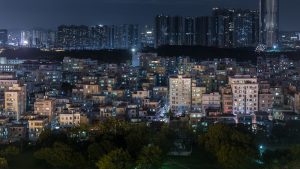2017 Bi-City Biennale of Urbanism \ Architecture (Shenzhen)
Cities, Grow in Difference
December 15, 2017–March 17, 2018
Bi-City Biennale of Urbanism\Architecture (UABB), the only exhibition in the world to explore issues of urbanization, will open for its 7th edition on December 15, 2017. It will be held at Nantou Old Town, a heterogeneous symbiosis of a historic town and a contemporary urban village in Shenzhen. Hou Hanru, Liu Xiaodu, and Meng Yan (in alphabetical order) make up the curatorial team, all known for notable accomplishments in their respective fields and trans-disciplinary practices. UABB is thrilled to host more than 200 exhibitors from 25 countries to share their perspectives on diversity and urban villages at this year’s biennale. A series of exhibitions are presented site-specifically in Nantou Old Town, with numerous artistic and architectural interventions in public spaces. Performances, forums and workshops will also be held, giving visitors a variety of exciting experiences.
The urban intervention of this year’s UABB is highly consistent with the Nantou Old Town regeneration plan. Renovation for exhibition spaces, architecture/art interventions, and organized events will bring an alternative experimental opportunity for the regeneration of Nantou Old Town and the renovation of urban villages in general.
Under the theme of Cities, Grow in Difference, three sections are presented, namely Global South, Urban Village, and Art Making City. The Global South section is curated by Liu Xiaodu, the Urban Village section is curated by Meng Yan, the above two sections of urbanism and architecture are co-curated by Zhu Ye. The Art Making Cities section is curated by Hou Hanru in collaboration with Yang Yong as co-curator.
The goal of Global South section is to provide a background, vision, and position for the biennial‘s theme. With Influence and Resistance as a subtitle, this section focuses on discussing the extensive interplay between regionalism and globalized power, capital, and cultural impetus. It also examines how they can reconcile the consequences of “differentiated modernity” through self-adaptation and self-retrofitting. In Shenzhen, the urban village is almost the only remaining original urban form of the South, and it is the only place where the resistance mechanism exists. The emergence of temporary and informal architecture has become an effective means of resisting northern influence.
The Urban Village section with subtitle of “Hybridity and Coexistence” is the main themed exhibition of this Biennale. The narrative line focuses on urban villages, representing a unique urban reality in Shenzhen and the Pearl River Delta region. The exhibition responds and interprets the theme of Cities, Grow in Difference from multiple perspectives, including historical research, in-depth observation, on-site intervention, and future imagination. The Urban Village section contains a series of themed exhibitions, research presentations, on- site exhibitions scattered throughout the old town, and miniature shows embedded within the main themed exhibition. It offers a series of spaces scattered on the ground floor, including a story den, game room, photo studio, drawing room, video room, music room, laboratory, future gallery, etc. It will become a hybrid of an exhibition and reality, also of dream and utopia. It is a factory, a laboratory, a workshop, a library, a gallery, a playground, and theme park, and it is also a window into the future.
The Art Making City section explores unorthodox city-making approaches and their effects on the local reality. Centering on Nantou Old Town, this section will highlight unique characteristics of urban villages with site-specific exhibits and actions. A series of urban art interventions will be conducted by the participants who have organized diverse social experiments with a strong emphasis on interaction and cooperation with local residents, creating an innovative, open and democratic urban system. More than 100 artists, architects, art organizations and design groups will be directly involved in this section, with multimedia works that unfold around themes such as “Street Life, Home and Social Production” and “People’s Wisdom.” These performances, videos, installations on the street, the factories, dormitories, and other sites come together to manifesting the indispensable power of art in city making.


